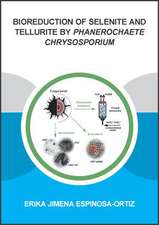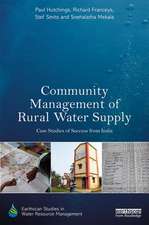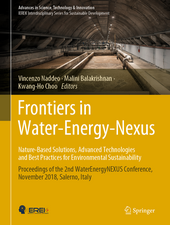Innovative Materials and Methods for Water Treatment: Solutions for Arsenic and Chromium Removal: Sustainable Water Developments - Resources, Management, Treatment, Efficiency and Reuse
Editat de Marek Bryjak, Nalan Kabay, Bernabe L. Rivas, Jochen Bundschuhen Limba Engleză Paperback – 30 iun 2021
The book is divided into three parts. The first one shows the effect of arsenic and chromium ions on living organisms. The second one presents the studies on preparation of innovative materials with improved affinity towards arsenic as well as chromium. The third part shows the innovative methods for removal of these toxic elements, with special attention paid to chromatographic, membrane, and hybrid systems.
The book is the first ever scientific work addressed to two most harmful elements appearing in water and provides a comprehensive review of materials and methods useful for making the water safe. The book discusses in detail the various fabrication techniques for sorbents and membranes that are now commercially available or appear in the development stage and will be commercialized in the next decades. Some of the technologies described in the third part will be implemented at the industrial scale in the future as well.
| Toate formatele și edițiile | Preț | Express |
|---|---|---|
| Paperback (1) | 455.42 lei 6-8 săpt. | |
| CRC Press – 30 iun 2021 | 455.42 lei 6-8 săpt. | |
| Hardback (1) | 887.81 lei 6-8 săpt. | |
| CRC Press – 17 feb 2016 | 887.81 lei 6-8 săpt. |
Preț: 455.42 lei
Nou
Puncte Express: 683
Preț estimativ în valută:
87.14€ • 91.23$ • 72.11£
87.14€ • 91.23$ • 72.11£
Carte tipărită la comandă
Livrare economică 05-19 aprilie
Preluare comenzi: 021 569.72.76
Specificații
ISBN-13: 9781138606593
ISBN-10: 1138606596
Pagini: 492
Dimensiuni: 174 x 246 x 28 mm
Greutate: 0.91 kg
Ediția:1
Editura: CRC Press
Colecția CRC Press
Seria Sustainable Water Developments - Resources, Management, Treatment, Efficiency and Reuse
ISBN-10: 1138606596
Pagini: 492
Dimensiuni: 174 x 246 x 28 mm
Greutate: 0.91 kg
Ediția:1
Editura: CRC Press
Colecția CRC Press
Seria Sustainable Water Developments - Resources, Management, Treatment, Efficiency and Reuse
Cuprins
Introduction to the problem of arsenic and chromium contaminations. Innovative Materials for Removal of arsenic and chromium. Innovative Methods for Removal of arsenic and chromium. Case studies: Latin America and the United States of America examples.
Notă biografică
Marek Bryjak, Nalan Kabay, Bernabe L. Rivas, Jochen Bundschuh
Descriere
Due to increasing demand for water potable and irrigation, water suppliers have to use alternative resources. They either have to regenerate wastewater or deal with contaminated surface water. This book brings together the experiences of various experts in preparing innovative materials selective for arsenic and chromium and performing innovative processes for removal of these two elements from water and will be of interest to engineers and decision makers responsible for safe water production and delivery.
The book is divided into two parts. The first part presents the studies on preparation of innovative materials with improved affinity towards arsenic as well as chromium. The second part shows the innovative methods for removal of these toxic elements and discusses the chromatographic, membrane, and hybrid systems.
The book is the first ever scientific work addressed to two most harmful elements appearing in water and provides a comprehensive review of materials and methods useful for making the water safe. The book discusses in detail the various fabrication techniques for sorbents and membranes that are now commercially available and employed or in the development stage and to be commercialized in the next decades. Some of the technologies described in the second part will be implemented at industrial scale in the future as well.
The book is divided into two parts. The first part presents the studies on preparation of innovative materials with improved affinity towards arsenic as well as chromium. The second part shows the innovative methods for removal of these toxic elements and discusses the chromatographic, membrane, and hybrid systems.
The book is the first ever scientific work addressed to two most harmful elements appearing in water and provides a comprehensive review of materials and methods useful for making the water safe. The book discusses in detail the various fabrication techniques for sorbents and membranes that are now commercially available and employed or in the development stage and to be commercialized in the next decades. Some of the technologies described in the second part will be implemented at industrial scale in the future as well.










